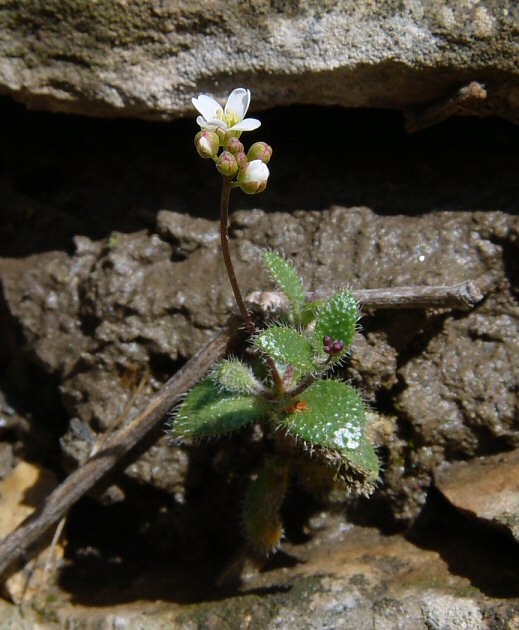Draba reptans (Lam.) Fernald
White Whitlow Wort

Native
CC = 2
CW = 5
MOC = 32
© DETenaglia
Draba reptans (Lam.) FernaldWhite Whitlow Wort | |
 |
Native CC = 2 CW = 5 MOC = 32 |
© DETenaglia |
|
Family - Brassicaceae Habit - Annual forb from a branched taproot. Stems - Erect, to 15 cm, 1 or few per plant, unbranched or few-branched from near the base, purplish below, hairy toward the base, some of the hairs branched, the inflorescence axis glabrous.
Leaves - In a basal rosette and also a few to several alternate toward the bases of the stems, 0.5-3.0 cm long, sessile or nearly so, narrowly elliptic to obovate, the margins entire, densely hairy on both surfaces, some of the hairs branched.
Inflorescence - Terminal compact raceme, elongating in fruit. Pedicels to 5 mm long in flower, longer in fruit. Flowers - Sepals 1-2 mm long. Petals 4, 2-5 mm long or less commonly absent, clawed, white, glabrous, usually rounded at the tip. Claw to 0.7 mm long. Limb to 2.1 mm long, 1.8 mm broad, rounded at apex. Stamens 6, erect. Filaments to 1.4 mm long, white, glabrous. Anthers yellow, 0.3 mm long. Ovary terete, green, 2 mm long, glabrous, 0.7 mm in diameter. Styles absent or to 0.1 mm long.
Fruits - Silicles 5-22 mm long, linear to narrowly oblong in outline, compressed, glabrous or hairy. Seeds 15-80 per fruit.
Flowering - February - May. Habitat - Glades, upland prairies, forest openings, fields, pastures, railroads, roadsides, and open, disturbed areas, on both calcareous and acidic substrates. Origin - Native to U.S. Lookalikes - Other species of Draba. Other info. - This tiny species is found in scattered locations across Missouri. It is scattered to uncommon throughout most of the continental U.S. It is easily overlooked as are many of the plants in this genus, and they are generally small and inconspicuous. This particular species is characterized by having unlobed petals and unlobed leaves which are found mostly near the base of the stem. Photographs taken at Eagle Bluffs Conservation Area, Boone County, MO., 3-14-03 and 4-11-04 (DETenaglia). |